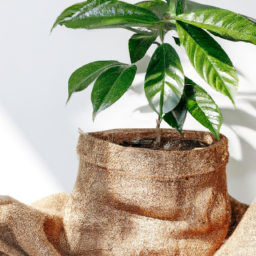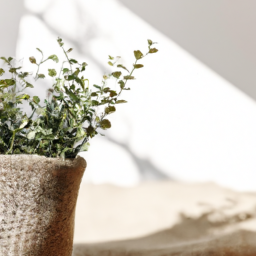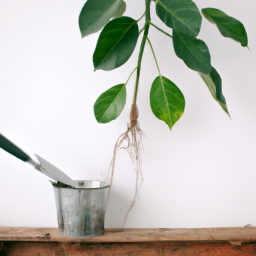
Have you ever wondered, “Do plants grow better indoors or outdoors?” It’s a common question among plant enthusiasts and those looking to start their own indoor garden. The debate between indoor and outdoor gardening has been ongoing for years, with each side having its own set of advantages and disadvantages. In this blog post, we will explore the factors that contribute to the growth of plants in both environments and help you determine which option may be best for your green thumb endeavors. So, grab your gardening gloves and let’s dig in!
Benefits of Growing Plants Indoors
Improved Air Quality
One of the key benefits of growing plants indoors is the improvement in air quality that they provide. Plants naturally absorb carbon dioxide and release oxygen through the process of photosynthesis. This helps to increase the oxygen levels in your home or office, making the air fresher and healthier to breathe. In addition, plants can also help to remove harmful toxins and pollutants from the air, such as formaldehyde and benzene, which are commonly found in indoor environments. By having plants indoors, you can create a cleaner and more oxygen-rich environment for yourself and your family.
Furthermore, indoor plants can also help to regulate humidity levels in your home. Plants release water vapor through a process called transpiration, which can help to increase the humidity in dry indoor spaces. This can be particularly beneficial during the winter months when indoor heating can cause the air to become dry and uncomfortable. By having a variety of plants indoors, you can create a more balanced and comfortable indoor environment for both yourself and your plants.
Overall, the improved air quality that indoor plants provide can have a positive impact on your health and well-being. By incorporating plants into your indoor spaces, you can breathe easier and enjoy a cleaner and more oxygenated environment.
Enhanced Mental Well-being
In addition to improving air quality, growing plants indoors can also have a positive impact on your mental well-being. Studies have shown that being surrounded by plants can help to reduce stress, anxiety, and depression. The presence of greenery indoors has a calming effect on the mind and can help to create a sense of tranquility and relaxation.
Furthermore, caring for plants can also provide a sense of purpose and accomplishment. Watching your plants grow and thrive can be incredibly rewarding and satisfying. This sense of fulfillment can help to boost your mood and overall sense of happiness.
Indoor plants can also help to improve focus and concentration. Having plants in your workspace or study area can help to create a more stimulating and inspiring environment, which can enhance productivity and creativity. By incorporating plants into your indoor spaces, you can create a more positive and uplifting atmosphere that can have a lasting impact on your mental well-being.
Year-round Growing Season
Another benefit of growing plants indoors is the ability to have a year-round growing season. Unlike outdoor gardening, where plants are subject to the changing seasons and weather conditions, indoor plants can be grown and cared for at any time of the year. This allows you to enjoy gardening and plant care regardless of the season.
Indoor gardening also provides more control over the growing conditions of your plants. You can adjust factors such as light, temperature, and humidity to create the ideal environment for your plants to thrive. This level of control can help to ensure that your plants grow healthy and strong, regardless of the external conditions.
Furthermore, growing plants indoors allows you to grow a wider variety of plants that may not be suited to your local climate or outdoor conditions. You can create a diverse and colorful indoor garden that includes a range of plant species from around the world. This can add interest and beauty to your indoor spaces, creating a unique and personalized environment for you to enjoy.

Factors Affecting Plant Growth Indoors vs. Outdoors
Light
When it comes to plant growth, light is one of the most crucial factors to consider. Indoors, plants rely on artificial light sources such as grow lights or fluorescent bulbs. While these can mimic natural sunlight to some extent, they may not provide the full spectrum of light that plants need to thrive. In contrast, outdoor plants have access to natural sunlight, which contains all the necessary wavelengths for optimal growth.
Plants grown indoors may struggle to receive enough light, especially if they are placed in a room with limited natural light or if the artificial light source is not powerful enough. This can lead to stunted growth, leggy stems, and pale leaves. On the other hand, outdoor plants have the advantage of being able to photosynthesize more efficiently, leading to healthier growth and stronger plants overall.
It’s important to consider the specific light requirements of the plants you are growing when deciding whether to keep them indoors or outdoors. Some plants, such as succulents and cacti, thrive in bright, direct sunlight and may not do well indoors. Others, like ferns and peace lilies, can tolerate lower light levels and may be better suited for indoor growing.
In general, if you want your plants to grow better and faster, outdoor growing is usually the way to go. However, with the right artificial lighting setup, you can still achieve successful plant growth indoors.
Temperature and Humidity
Another important factor to consider when deciding whether to grow plants indoors or outdoors is temperature and humidity. Indoor environments are often more controlled, with stable temperatures and humidity levels. This can be beneficial for certain plants that prefer consistent conditions.
Plants grown outdoors are exposed to fluctuating temperatures and humidity levels, which can be challenging for some species. However, outdoor plants also have the advantage of being able to benefit from natural air circulation, which can help prevent issues like mold and mildew.
In general, most plants prefer temperatures between 65-75°F during the day and slightly cooler temperatures at night. Indoor plants can easily thrive in these conditions, while outdoor plants may require extra protection during extreme weather conditions.
When it comes to humidity, indoor plants may benefit from a humidifier to increase moisture levels in the air. Outdoor plants, on the other hand, may require regular watering to maintain adequate moisture levels in the soil.
It’s important to research the specific temperature and humidity requirements of the plants you are growing to ensure they have the best chance of success, whether indoors or outdoors.
Soil and Nutrients
The type of soil and nutrients available to plants can also impact their growth and overall health. Indoor plants are typically grown in potting mix or soilless mediums, which are specifically formulated to provide the necessary nutrients for plant growth. These mediums are often lightweight and well-draining, which can help prevent issues like root rot.
Outdoor plants, on the other hand, may be grown in garden soil, which can vary in quality and nutrient content. It’s important to amend garden soil with compost or fertilizer to ensure plants have access to the nutrients they need to thrive.
In addition to soil quality, the availability of nutrients is also crucial for plant growth. Indoor plants may require regular fertilization to replenish nutrients that are depleted over time. Outdoor plants can benefit from natural sources of nutrients, such as compost or organic matter.
When deciding whether to grow plants indoors or outdoors, consider the specific soil and nutrient requirements of the plants you are growing. Some plants may thrive in a soilless medium indoors, while others may require the nutrient-rich soil of an outdoor garden.
In conclusion, there are several factors to consider when deciding whether to grow plants indoors or outdoors. Light, temperature, humidity, soil, and nutrients all play a role in determining the success of your plants. By understanding the specific needs of the plants you are growing and providing them with the right conditions, you can help ensure they grow better and healthier, whether indoors or outdoors.

Tips for Optimizing Plant Growth in Indoor and Outdoor Environments
Understanding the Differences Between Indoor and Outdoor Plant Growth
When it comes to growing plants, whether indoors or outdoors, there are several key differences to consider. Indoor plants are typically grown in a controlled environment, where factors such as temperature, humidity, and light can be easily adjusted. Outdoor plants, on the other hand, are subject to the natural elements, such as sunlight, rain, and wind.
One of the main advantages of growing plants indoors is the ability to control the environment. This means that you can adjust the temperature, humidity, and light levels to create the ideal growing conditions for your plants. Indoor plants also tend to be less susceptible to pests and diseases, as they are not exposed to the same outdoor elements.
On the other hand, outdoor plants have the advantage of natural sunlight, which is essential for photosynthesis and plant growth. Outdoor plants also have access to natural sources of water and nutrients, which can help them thrive. However, outdoor plants are more vulnerable to pests, diseases, and extreme weather conditions.
Tips for Optimizing Indoor Plant Growth
When it comes to growing plants indoors, there are several key factors to consider in order to optimize plant growth. One of the most important factors is light. Most indoor plants require at least 6-8 hours of sunlight per day, so it is important to place your plants near a window where they can receive adequate light. If natural sunlight is not available, you can use grow lights to supplement the light levels.
Another important factor to consider is humidity. Indoor plants thrive in humid environments, so it is important to mist your plants regularly or place a humidifier nearby. You can also group your plants together to create a microclimate with higher humidity levels.
In addition to light and humidity, it is important to water your indoor plants regularly. Overwatering can lead to root rot, while underwatering can cause your plants to wilt and die. It is important to water your plants when the top inch of soil feels dry to the touch, and to use a well-draining potting mix to prevent waterlogged soil.
Tips for Optimizing Outdoor Plant Growth
When it comes to growing plants outdoors, there are several key factors to consider in order to optimize plant growth. One of the most important factors is sunlight. Most outdoor plants require full sun, which means at least 6-8 hours of direct sunlight per day. It is important to choose the right location for your plants, taking into account factors such as shade, wind, and soil quality.
Another important factor to consider is water. Outdoor plants require regular watering, especially during hot weather. It is important to water your plants deeply and infrequently, to encourage deep root growth. You can also mulch around your plants to help retain moisture in the soil.
In addition to sunlight and water, it is important to fertilize your outdoor plants regularly. Fertilizer provides essential nutrients that plants need to grow and thrive. It is important to choose a fertilizer that is appropriate for the type of plants you are growing, and to follow the instructions on the label.
By following these tips for optimizing plant growth in indoor and outdoor environments, you can help your plants thrive and flourish. Whether you are growing plants indoors or outdoors, it is important to provide the right conditions for your plants to grow and thrive. With the right care and attention, you can enjoy a beautiful and bountiful garden, whether it is indoors or outdoors.
Key Takeaways
When it comes to growing plants, the age-old debate of whether they thrive better indoors or outdoors always seems to come up. While some people swear by the benefits of outdoor gardening, others prefer the convenience and control of indoor growing. The truth is, both options have their pros and cons, and the decision ultimately depends on the type of plant you’re growing and the conditions in which you can provide for it.
Indoor plants tend to grow better in controlled environments where temperature, light, and humidity levels can be easily regulated. This can be especially beneficial for delicate or exotic plants that require specific conditions to thrive. On the other hand, outdoor plants have the advantage of natural sunlight, fresh air, and access to natural nutrients in the soil. They also have more space to grow and spread their roots, which can lead to larger and healthier plants in the long run. Ultimately, the best option for your plants will depend on your specific growing conditions and the type of plant you’re trying to cultivate.
Frequently Asked Questions from our readers:
Q1. Can plants grow better indoors or outdoors?
Plants can grow well both indoors and outdoors, but the success of growth depends on various factors such as light, temperature, humidity, and care.
Q2. What are the benefits of growing plants indoors?
Growing plants indoors can provide a controlled environment where you can regulate factors like light and temperature. It also allows you to grow plants year-round regardless of the weather outside.
Q3. What are the benefits of growing plants outdoors?
Growing plants outdoors allows them to receive natural sunlight, fresh air, and rainwater. Outdoor plants may also have more space to grow and thrive compared to indoor plants.
Q4. How can I ensure plants grow well indoors?
To ensure plants grow well indoors, make sure they receive enough light, proper watering, and the right temperature and humidity levels. You may also need to provide additional nutrients through fertilizers.
Q5. How can I ensure plants grow well outdoors?
To ensure plants grow well outdoors, choose the right location with adequate sunlight and soil quality. Regular watering, pruning, and protection from pests and diseases are also essential for outdoor plant growth.

James Wong is a renowned ethnobotanist, plant scientist, and local television presenter. With a passion for demystifying plant science, he is known for translating complex botanical concepts into practical advice for everyday plant enthusiasts. James’s expertise spans from traditional gardening to cutting-edge plant technologies, making his insights accessible and informative.


